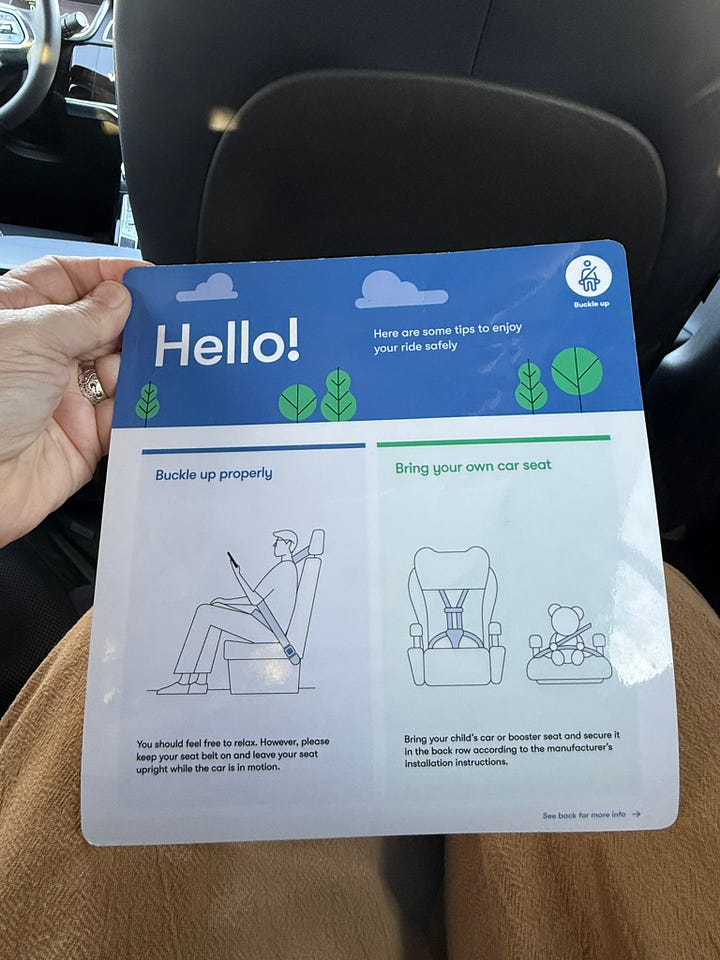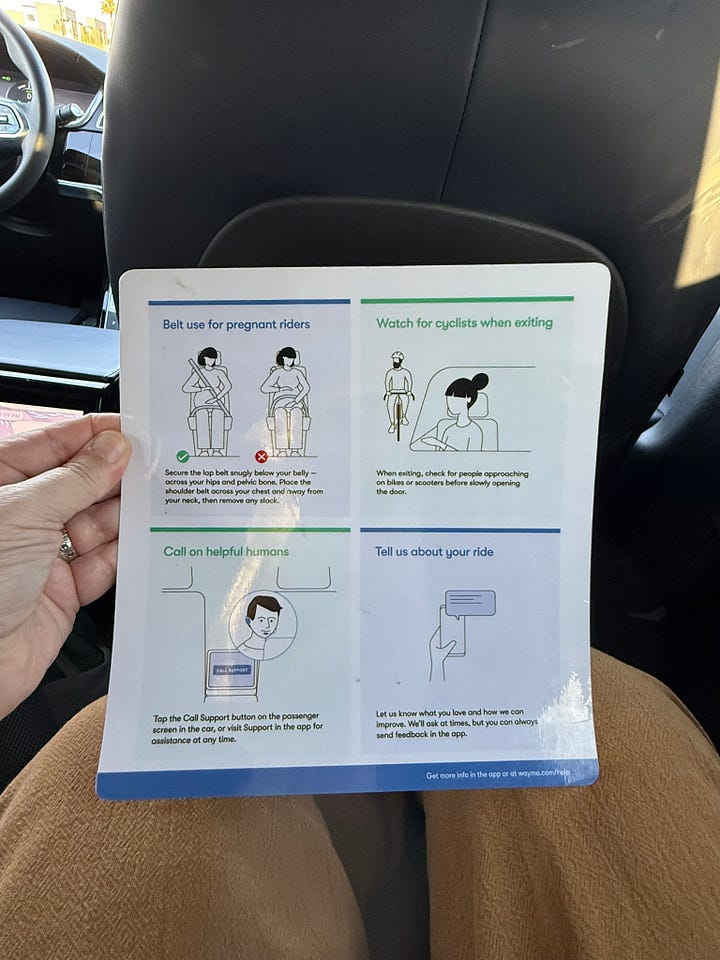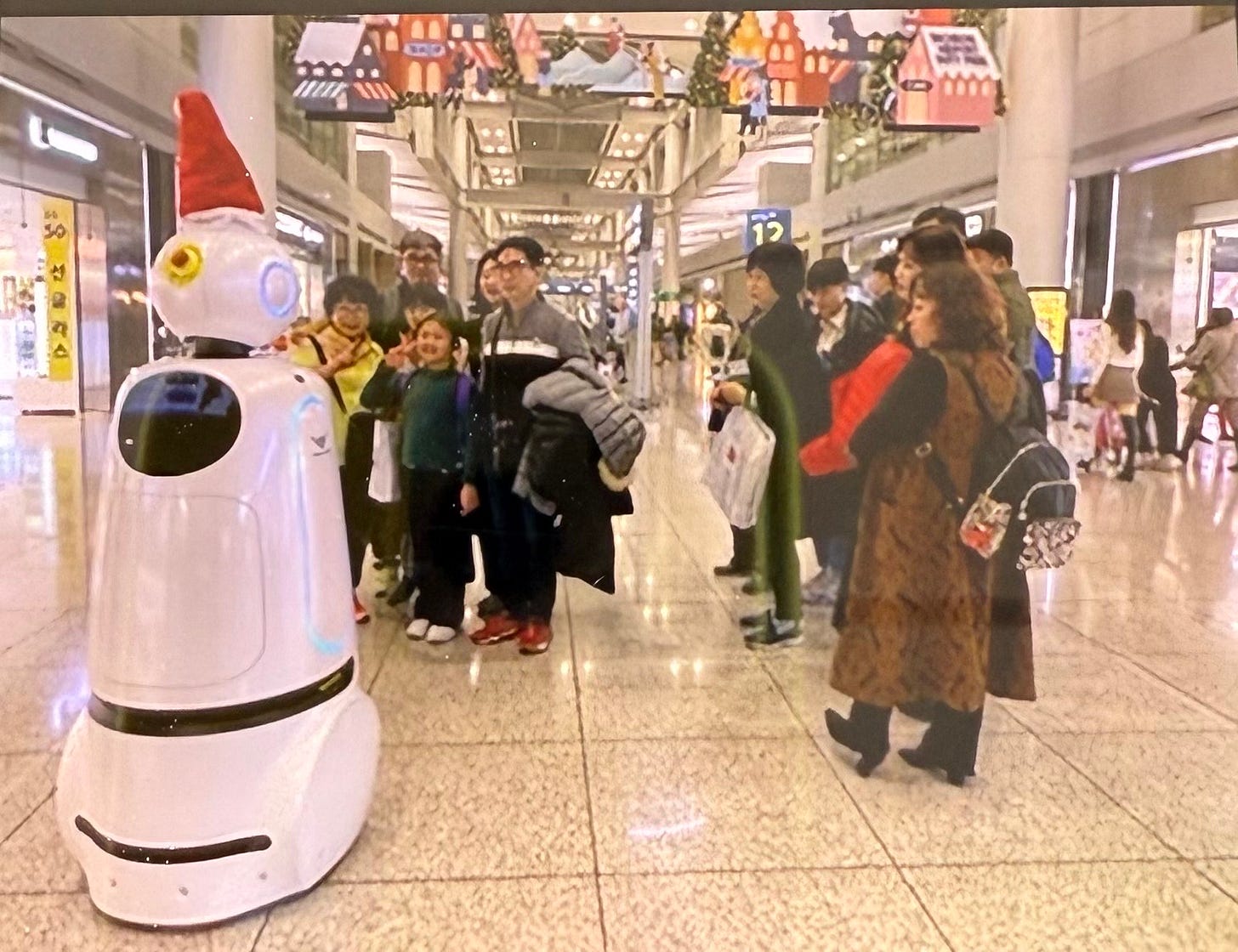US Culture Shock – Robot edition
Our annual trip to the US surprised us, and not in the way we expected
This year, as we planned our trip to the US to see family and friends before taking off to Europe for the spring, we fully expected to be blown away by the cultural revolution taking place under Trump’s second administration. It dominated the news in Mexico and talk within our community, and we had many sad and emotional conversations with dear Canadian friends who are genuinely feeling the chaos coming out of Washington. So we girded ourselves for the conversations we expected to have with friends, family, and strangers in the US. Not to make light of what is clearly a devastating time, but our culture shock was nothing like we anticipated. Discussions with friends and family were meaningful and considerate or avoided topics altogether if they might derail an otherwise welcome time together.
What totally blew us away were the robots. So many robots. How had the US changed so much in just one year?
We’ve spent considerable time outside of the US in the past where we noticed big changes in the availability and use of technology, or lack thereof, on trips home. When we left the US for Egypt in 2000, barely anyone had a personal flip phone or Blackberry, digital cameras were crazy expensive, and those of us with Netflix subscriptions were thrilled to get DVDs in the mail days to weeks after ordering them online – so much more advanced than walking into Blockbuster to pick out movies to rent from whatever was left on the shelves.
Technology in Africa far outpaced the speed of advancements in the US during those years. We had faster and more comprehensive cell phone coverage as African countries were able to leapfrog the US by installing new technology infrastructure while the US was struggling to retrofit decades old systems, towers, and monolithic telephone and cable companies. We were ordering online food delivery in Egypt long before Uber Eats, Door Dash, or any other US delivery business was even being tested. We were texting for free in Zambia and South Africa as the normal way of communicating before it became standard in the US, where there was also a cost per text in the early days. And we had online banking and electronic payments in South Africa and Kenya years before these capabilities made it to the US. It was way easier to send money via cell phone to a nomadic cattle herder in the Maasai Mara than it was to reimburse a friend for coffee in the US without using cash.
But our perception of the automation of America changed drastically when we arrived in Phoenix in mid-March. A TV ad by Cox Communications we saw soon after arriving showed us a family so happy to have fully integrated automated lives with their beloved inanimate objects – phones, TVs, computers, lights, thermostats, refrigerators, coffee makers, home security, cars, and more all controlled with one internet account. And we were met with hordes of self-driving cars, food delivery robots, automated airport convenience stores, and parking garage attendants. I couldn’t help wonder if the robots had conquered America while we were all busy looking down at our smart phones.
Waymo – let the robot car do the driving
We heard about Google’s Waymo for the first time a few months ago from a YouTuber we follow who had recently visited Phoenix and took a Waymo from the airport to his hotel. As freaky as it looked to be driven around in a car with no driver, we really wanted to give it a try. And after seeing loads and loads of Waymo cars circling the Tempe neighborhood where we were staying, we downloaded the app, booked a car, and a few minutes later took off on a 30 minute drive to visit with old friends in North Scottsdale.
According to “Prof G” Scott Galloway, if you ask most Americans to name a self-driving car company, they will say Tesla. But in reality, Waymo is miles ahead. Last year, Tesla, Amazon’s Zoox, and GM’s Cruise all banked 0 autonomous trips. Waymo is currently operating in San Francisco, Austin, Los Angeles, Phoenix, some parts of Atlanta, and will soon roll out in Washington, DC. In San Francisco alone, Waymo now accounts for 22% of the ride hailing market – excluding freeways and to the airport – despite often being slower and pricier than Uber and Lyft. Across its current markets, Waymo now serves over 200,000 paid rides per week – roughly the output of 1,500 human Uber and Lyft driver hours.
At the time we booked our car, Waymo was about $10 more than if we had booked an Uber, but that seemed to be more related to surge pricing than any real price difference as we were traveling around the same time that every Arizona State University student was heading out for Saturday night fun. ASU has a special deal with Waymo where students pay a nominal fee for each ride. When we checked at other times, prices were about the same as Uber or Lyft.
The very comfortable, if somewhat already abused, Jaguar covered in sensors picked us up at a designated meeting spot about a block from our accommodations, had Levon’s initials on the car’s roof sensor so we could easily tell it was our car, popped open the door handles when Levon confirmed in the app that we were the designated passengers, and we got into the back seat. As soon as the car confirmed we had buckled up, it started to drive and a calm, female voice told us not to freak out and gave us a brief orientation to the car and experience. We were able to change the music, volume, and temperature, but in no circumstances should we touch the steering wheel. We then sat back and enjoyed the weirdest, but strangely not weird, car ride outside of an amusement park.


At the end of our ride, the same calm female voice prepared us for how the car would stop, park, and wait for us to exit. There was no chit chat with the driver, just an easy, stress-free ride in relatively busy traffic while we videoed and photographed everything. And no tipping required.
Yeah, but is Waymo safe? Using human crash data, Waymo estimates that human drivers on the same roads would get into 78 crashes serious enough to trigger an airbag. By comparison, Waymo’s driverless vehicles got into 13 airbag crashes over the same period. That represents an 83% reduction in airbag crashes relative to typical human drivers. Waymo completed 25 million driverless miles by July 2024. By the end of November 2024, Waymo had faced only two potentially successful insurance claims for bodily injury. And based on data reviewed by Arstechnica.com, it seems unlikely that an insurance adjuster will ultimately hold Waymo responsible for the injuries caused.
We took an Uber home that night, driven by a lovely young woman who seemed like she needed to chat to stay awake. She drove us in her Tesla and her Uber app seemed to be confused as to where we were and where we were going, since it instructed her to take three wrong turns before finally being on our way home for the night. Score – Waymo 1, Humans/Uber/Tesla 0.
Other robots were everywhere, but not always the most helpful
It seemed that everywhere we turned, the US is more and more automated and while for the most part that worked, there were times when it really backfired.
Like when we picked up our Avis rental car from the small, charming regional airport in Charleston, South Carolina and couldn’t get out of the parking lot. Since I hadn’t thought to top up my phone’s data before leaving the Wi-Fi in the airport terminal and the Avis app with our reservation was only on my phone, we couldn’t scan out of the rental car parking garage. So, we sat at the gate holding up traffic (luckily pretty light at that time of night) until a human could run down from the office and let us out. And then my 6-month-old iPhone 16 Pro experienced glitch after glitch after glitch requiring us to make three separate trips to the Apple Genius bar about an hour’s drive from my sister’s house. All automated scans of the phone said it was fine, but it was definitely not fine. It took a human manually wiping the phone and installing new software to get it working again. And as if my phone and computer decided to go on strike at the same time, my trusty Dell started to overheat and could no longer delete, add, or repair the Google suite of programs I use to work. So, off to Best Buy the day before we started traveling again where genuinely helpful human sales associates evaluated my old laptop, gave me a trade in voucher, and guided me in picking out a new laptop. Humans 3, robots 0.
But there were lots of robots and technology working just fine. Like the little coolers driving themselves around the ASU campus in Tempe delivering takeout food (I missed getting a photo of one of these robots crossing the street in front of us and then getting passed by loads of students who didn’t give it a second look). And an Amazon branded convenience store in the tiny Charlston airport with automated checkout (“Just Walk Out” was posted on the turnstile at the entrance of the store) where the humans cleaned the floors and stocked the shelves, but didn’t handle any of the financial transactions. This seemed an awful lot like the robots were taking entry level jobs from the humans. Was this a win for the humans or the robots? I’m calling this a draw.
I am thoroughly confused by the Trump administration’s design to bring manufacturing back to the US. How exactly is that going to work? Robots in the US are already making pizzas, building cars, doing manicures, and more. I would be there are even robots making other robots. I can’t imagine too many young people aspiring to go work at the robot factories wherever they may be built – they want to be served by robots, not at the beck and call of the robots themselves. A man sitting at the same table as us the Apple Genius Bar heard me complaining about my iPhone said, “I bet these phones will be better when they bring making them back to the US.” I honestly don’t remember what I replied once I lifted my jaw off the floor and somewhat gathered my wits. But I think that will cause significantly more problems before it (potentially) solves anything for the US economy, job opportunities, and quality of life for its humans.
Mexico and many of the other places we travel have a long way to go to catch up to the progress the US is making technologically – but, when the power goes off, everything still works, commerce continues, schools still teach, food is bought and cooked, and people don’t miss a beat. And we love this. So, I am trapped somewhere between wanting to keep some of our lives off grid where we have the freedom to work, play, and live without the robots. And yet, we are of the Jetsons generation, where we grew up expecting to have flying cars, robots cleaning our homes, and houses floating in space by the time we were adults.
I am really looking forward to our travel this fall to Southeast Asia. We’ve come to expect next level technology from the region - we’ve booked a robot run hotel in Tokyo, we are pretty passionately in love with Japanese and Korean toilets (if you know, you know), and few robots have charmed us more than the helpful courtesy robot wearing a Santa hat when we visited Incheon Airport a few years ago over the holidays.
So, if you see me in line to welcome our new robot overlords while at the same time complaining that I want to be off the grid, please don’t judge.
P.S. I once saw an escaped Rumba chugging down the street by itself in front of Eastern Market in Washington, DC as I was on my way to work one morning. There was no one else around and I struggled with what to do – pick it up and try to figure out who to return it to? How did it get out of its house? Did it mean to? Had it been set free? Was I on a hidden camera show? I had so many questions as I hurried my way to the Metro trying to look as cool as possible. I still think about that renegade rumba on a regular basis.







Fascinating glimpse into the robot era… I had no idea! Thanks for giving me a first-hand look!
In Northern California, I have yet to see robots, although it has been years since I have been in the city of Sacramento to know what is rolling about. I did see them in the London airport and took the standard video of the cute little thing.
It would be wonderful to try out the self driving car for trips to the airport. More often than not, the Lyft/Uber drivers are sketchy, a bit over-chatty, and their topics of discussion usually fall to politics -of which I have no interest in.
I dream of living in rural quietness, where the activity is a town square with a farmer's market, shops, restaurants and coffee. Only experiencing the Jetson's technology on infrequent vacations to urban cities and when I can prepare for the overload.